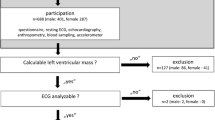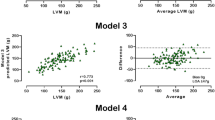Abstract
The identification of left ventricular hypertrophy (LVH) through electrocardiographic voltage criteria has been widely studied in patients. However, their validity in “athlete’s heart” remains quite unknown. The aim of this study was to evaluate the most common electrocardiographic indices indicative of LVH compared to the known echocardiographic ones in athletes. The study group comprised 150 male adult competitive athletes (group A) and 50 sedentary participants (group B). Thirteen accepted electrocardiographic voltage criteria indicative of LVH were calculated and correlated with the common echocardiographic indices of left ventricular mass (LVM). Nine of the 13 ECG voltage criteria were significantly increased in athletes compared to controls. Statistically, the Sokolow–Lyon index, which is the most commonly used voltage index was found to be affected by the body mass index (10.7 %, p < 0.05), the group (7.3 %, p < 0.05) and systolic blood pressure (4.5 %, p < 0.05) in total variance of 16.6 % (p < 0.05). No electrocardiographic voltage criterion was significantly correlated with any echocardiographic index, except for the Cornell index that was correlated with end-diastolic volume index (r = 0.29, p < 0.05) and the Sokolow index (V6) with LVMI (r = 0.26, p < 0.05) in group A. We suggested that ECG voltage indices should not be considered valid when assessing LVH in athletes. Thus, the echocardiographic study is preferable in studying training-induced structural cardiac changes.

Similar content being viewed by others
References
Pavlik G, Major Z, Varga-Pintér B et al (2010) The athlete’s heart. Part I (Review). Acta Physiol Hung 97:337–353
Lalande S, Baldi JC (2007) Left ventricular mass in elite Olympic weight lifters. Am J Cardiol 100:1177–1180
Corrado D, Pelliccia A, Heidbuchel H et al (2010) Section of Sports Cardiology, European Association of Cardiovascular Prevention and Rehabilitation. Recommendations for interpretation of 12-lead electrocardiogram in the athlete. Eur Heart J 31:243–259
Oakley CM (1992) The electrocardiogram in the highly trained athlete. Cardiol Clin 10:295–302
Bjørnstad H, Storstein L, Meen HD, Halls O (1991) Electrocardiographic findings in athletic students and sedentary controls. Cardiology 79:290–305
DuBois D, DuBois EF (1916) A formula to estimate the approximate surface area if height and weight be known. Arch Intern Med 17:863–871
Siegel RJ, Roberts WC (1982) Electrocardiographic observations in severe aortic valve stenosis: correlative necropsy study to clinical, hemodynamic, and ECG variables demonstrating relation of 12-lead QRS amplitude to peak systolic transaortic pressure gradient. Am Heart J 103:210–221
Sokolow M, Lyon TP (1949) The ventricular complex in left ventricular hypertrophy as obtained by unipolar precordial and limb leads. Am Heart J 37:161–186
Molloy TJ, Okin PM, Devereux RB, Kligfield P (1992) Electrocardiographic detection of left ventricular hypertrophy by the simple QRS voltage-duration product. J Am Coll Cardiol 20:1180–1186
Dollar AL, Roberts WC (1989) Usefulness of total 12-lead QRS voltage compared with other criteria for determining left ventricular hypertrophy in hypertrophic cardiomyopathy: analysis of 57 patients studies at necropsy. Am J Med 87:377–381
Gubner R, Ungerleider HE (1943) Electrocardiographic criteria of left ventricular hypertrophy. Factors determining the evolution of the electrocardiographic pattern in hypertrophy and bundle branch block. Arch Intern Med 72:196–209
Lang RM, Bierig M, Devereux RB et al (2005) Recommendations for Chamber Quantification: a Report from the American Society of Echocardiography’s Guidelines and Standards Committee and the Chamber Quantification Writing Group, Developed in Conjunction with the European Association of Echocardiography, a Branch of the European Society of Cardiology. J Am Soc Echocardiogr 18:1440–1463
Devereux RB, Reichek N (1977) Echocardiographic determination of left ventricular mass in man. Anatomic validation of the method. Circulation 55:613–618
Teichholz LE, Kreulen T, Herman MV, Gorlin R (1976) Problems in echocardiographic volume determinations: echocardiographic-angiographic correlations in the presence of absence of asynergy. Am J Cardiol 37:7–11
Pelliccia A (2007) The preparticipation cardiovascular screening of competitive athletes: is it time to change the customary clinical practise? Eur Heart J 28:2703–2705
Deligiannis A, Anastasakis A, Antoniades L et al (2010) Recommendations for the cardiovascular screening of athletes. Hell J Cardiol 51:530–537
Maron BJ, Thompson PD, Ackerman MJ et al (2007) Recommendations and considerations related to preparticipation screening for cardiovascular abnormalities in competitive athletes: 2007 update: a scientific statement from the American Heart Association Council on Nutrition, Physical Activity, and Metabolism: endorsed by the American College of Cardiology Foundation. Circulation 115:1643–1655
Wheeler MT, Heidenreich PA, Froelicher VF et al (2010) Cost-effectiveness of preparticipation screening for prevention of sudden cardiac death in young athletes. Ann Intern Med 152:276–286
Perez M, Fonda H, Le V–V et al (2009) Adding an electrocardiogram to the pre-participation examination in competitive athletes: a systematic review. Curr Prob Cardiol 34:586–662
Maron BJ, McKenna WJ, Danielson GK et al (2003) American College of Cardiology/European Society of Cardiology clinical expert consensus document on hypertrophic cardiomyopathy: a report of the American College of Cardiology Foundation Task Force on Clinical Expert Consensus Documents and the European Society of Cardiology Committee for Practise Guidelines. J Am Coll Cardiol 42:1687–1713
Fuller CM, McNulty CM, Spring DA et al (1997) Prospective screening of 5615 high school athletes for risk of sudden cardiac death. Med Sci Sport Exer 29:1131–1138
Corrado D, Pelliccia A, Bjornstad HH et al (2005) Study Group of Sport Cardiology of the Working Group of Cardiac Rehabilitation and Exercise Physiology and the Working Group of Myocardial and Pericardial Diseases of the European Society of Cardiology. Cardiovascular pre-participation screening of young competitive athletes for prevention of sudden death: proposal for a common European protocol. Eur Heart J 26:516–524
Antman EM, Green LH, Grossman W (1979) Physiologic determinants of the electrocardiographic diagnosis of left ventricular hypertrophy. Circulation 60:386–396
Carlsson MB, Trägårdh E, Engblom H et al (2006) Left ventricular mass by 12-lead electrocardiogram in healthy subjects: comparison to cardiac magnetic resonance imaging. J Electrocardiol 39:67–72
Brody DA (1956) A theoretical analysis of intracavitary blood mass influence on the heart-lead relationship. Circ Res 4:731–738
Douglas PS, O’ Tool ML, Hiller WPD et al (1988) Electrocardiographic diagnosis of exercise-induced left ventricular hypertrophy. Am Heart J 116:784–790
Ikäheimo M, Palatsi I, Takkunen J (1979) Non invasive evaluation of the athlete heart: sprinters versus endurance runners. Am J Cardiol 44:24–30
Bjørnstad H, Storstein L, Meen HD, Halls O (1993) Electrocardiographic findings of left, right and septal hypertrophy in athletic students and sedentary controls. Cardiology 82:56–65
Bjørnstad H, Smith G, Storstein L, Halls O (1993) Electrocardiographic and echocardiographic findings in top athletes, athletic students and sedentary controls. Cardiology 82:66–74
Rawlins J, Bhan A, Sharma S (2009) Left ventricular hypertrophy in athletes. Eur J Echocardiogr 10:350–356
Kinoshita N, Onishi S, Yamazaki H et al (2003) Recognition of left ventricular hypertrophy in new recruits of professional sumo wrestling. J Sci Med Sport 6:379–386
Devereux RB, Phillips MC, Casale PN et al (1999) Geometric determinants of electrocardiographic left ventricular hypertrophy. Circulation 67:907–911
Sharma S, Whyte G, Elliott P et al (1999) Electrocardiographic changes in 1000 highly trained junior elite athletes. Brit J Sport Med 33:319–324
Somauroo JD, Pyatt JR, Jackson M et al (2001) An echocardiographic assessment of cardiac morphology and common ECG findings in teenage professional soccer players: reference ranges for use in screening. Heart 85:649–654
Okin PM, Roman MJ, Devereux RB, Kligfield P (1995) Electrocardiographic identification of increased left ventricular mass by simple voltage-duration products. J Am Coll Cardiol 25:417–423
Rogelio AM, Vazguez MLR, Nordaby RA et al (2005) Distance correction in the electrocardiographic estimation of left ventricular mass. J Electrocardiol 38:58–63
Levy D, Labib SB, Anderson KM et al (1990) Determinants of sensitivity and specificity of electrocardiographic criteria for left ventricular hypertrophy. Circulation 81:815–820
Xie L, Wang Z (2010) Correlation between echocardiographic left ventricular mass index and electrocardiographic variables used in left ventricular hypertrophy criteria in Chinese hypertensive patients. Hell J Cardiol 51:391–401
Abächerli R, Zhou L, Schmid JJ et al (2009) Correlation relationship assessment between left ventricular hypertrophy voltage criteria and body mass index in 41,806 Swiss conscripts. Ann Noninvas Electro 14:381–388
Pellicia A, Maron BJ, Culasso F et al (2000) Clinical significance of abnormal electrocardiographic patterns in trained athletes. Circulation 102:278–284
Bellenger NG, Davies LC, Francis JM et al (2000) Reduction in sample size for studies of remodeling in heart failure by the use of cardiovascular magnetic resonance. J Cardiovasc Magn Reson 2:271–278
De Castro S, Pelliccia A, Caselli S et al (2006) Remodelling of the left ventricle in athlete’s heart: a three dimensional echocardiographic and magnetic resonance imaging study. Heart 92:975–976
Conflict of interest
None.
Author information
Authors and Affiliations
Corresponding author
Rights and permissions
About this article
Cite this article
Dimitros, E., Koutlianos, N., Anifanti, M. et al. Comparative study of ECG and echocardiographic parameters indicative of cardiac hypertrophy in athletes. Sport Sci Health 8, 101–107 (2012). https://doi.org/10.1007/s11332-012-0136-3
Received:
Accepted:
Published:
Issue Date:
DOI: https://doi.org/10.1007/s11332-012-0136-3




